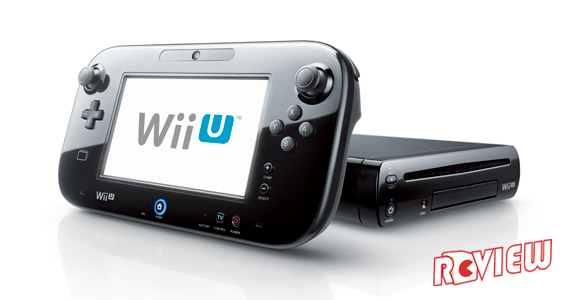
Nintendo’s successor to the Wii has landed, aiming to maintain the dominance of the Wii while raising the processing power that cost the Wii plenty of third party titles – not that the system severely lacked unique third party offerings all its own, there were just very few of us who ever seemed to buy them.
As with anytime new hardware arrives, I’ll claim to have no proper idea of how one judges and measures a device that does more to lay the foundation for future developments versus turning the gaming industry on its ear overnight – of course I’ll fumble through an attempt all the same. I’m not so concerned about being on the right side of history with my opinions, but rather with getting you as much information as possible.
With that said, I hope you’ll read on for a closer look at the hardware and my initial attempts to field the most pressing questions for anyone considering taking the leap this year – and your questions are the most important ones, so please hit me up in the comments and I’ll work to answer any and all questions you have.
What’s In the Box?
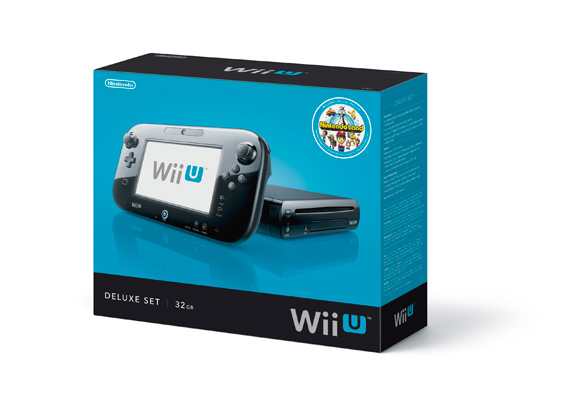
This review is based on the Wii U Deluxe Set, which includes a Wii U console with 32GB internal storage, the Wii U gamepad, AC adapters for both the console and gamepad, an HDMI cable for the console, Sensor Bar to support pre-existing Wii peripherals (your old Wii-Motes), stands for both the gamepad and to enable the Wii U console to sit on its side, a copy of Nintendo Land, and a charging cradle for the gamepad.
The AC adapter for the console is larger than the original Wii’s, while the charging cable for the gamepad can be connected to the cradle or directly into the top of the gamepad to recharge its battery. The charge cable’s AC adapter allows it to be plugged into an outlet rather than the console, which allows the cradle to be conveniently placed near a sitting area rather than near the console itself.
The Wii U Console
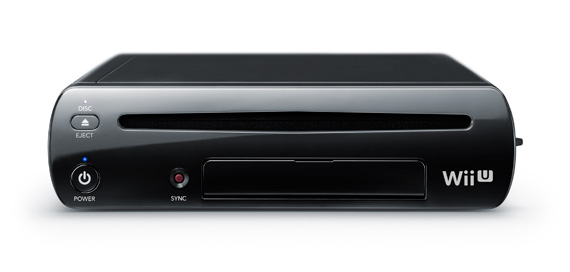
The Wii U console is essentially a longer and slightly wider successor to the design of the Wii, with a bit more weight to boot – still slim enough to take up a fraction of the space owned by the original release models of the Xbox 360 and PlayStation 3 and able to stand on its side with the aid of the Deluxe Set’s cradle.
One curious design decision is that even when the machine is turned off, a white light will remain lit if a disc is in the console as a reminder. In addition to the front power, eject and sync buttons, a flip down panel reveals an SD card slot as well as two USB ports – two more USB ports are on the back of the console to bring the total to four.
One of the first things I checked when hooking up the 32GB Deluxe Set was to check the internal storage space available following the setup, which showed 25GB’s free. Rather than competing with Sony and Microsoft in the ever-escalating internal storage re-release wars, Nintendo has opted to provide the four USB ports for external storage options. The minute you plug a storage device in, whether it be an external hard drive or a thumb drive, accessing data management in the system settings will offer the chance to format it for use with the system. It may seem more complicated than simply paying Nintendo for a larger hard drive out of the gate, but it provides the option for some less taken with digital purchases to save money initially, and for others to make their own storage decisions.
It’s definitely worth noting that this is the first gaming console to ship with an HD cable. If you’re not using an HD television, the existing cable from your Wii will still work on the back end of the Wii U.
The Wii U Gamepad
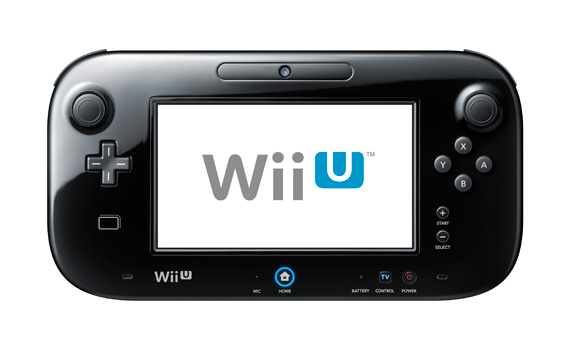
Short sessions with the gamepad at various events throughout this year hasn’t made it easy to form an opinion – certainly not when considering that public appearances also see it tethered to a power source to ensure it doesn’t run low on juice during showings.
Being able to sink into the couch for hours with the gamepad has revealed that this is the most comfortable device I’ve ever held in my hands. The width of the device seems ideal for staving off the hand cramping that I often experience with portable devices, and the ability to move around my home to some degree, at times ignoring the television completely and leaving the room where the console is running, goes a long way to cutting the chains of the home console experience. The gamepad specs state that it weighs 1.1 pounds – all I can add is that the weight is barely noticeable compared to other handheld gaming devices like the Vita and 3DS.
Early range tests find me able to operate the gamepad in any adjacent room, and it continues to work while occupying the room directly over the console as well, though walking up the stairs to reach that destination will cause the screen to pause and advise me that I’m out of range temporally. Range will greatly depend on the design of your own home, but if your kitchen is next to the living room, I imagine you’ll have no trouble grabbing a drink while continuing to play.
The gamepad features a traditional directional pad on one side and four face buttons on the other, both located beneath the dual analog sticks. The front side of the gamepad also adds start and select buttons, a home button offering quick access to the Wii U menu, a TV button for accessing the remote control feature, and a power button that allows you to turn the machine on and off without touching the console. The front also includes a microphone hole, camera, and a battery life indicator.
While playing New Super Mario Bros. U for review, I was able to give the battery life of the gamepad a good test run, which uses a rechargeable lithium-ion battery – finding that at approximately three hours of consistent use a red warning light signaled from the pad that a recharge was in order. I pushed on for about twenty more minutes before surrendering to its demands.
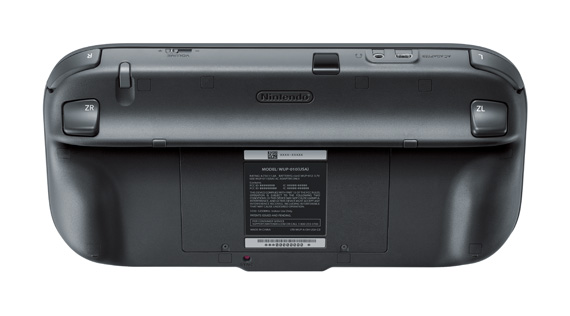
The back of the gamepad features two shoulder buttons and two triggers, which fit my hands rather sweetly and add to the feeling that I’ve never had such a comfortable grip that also allows me to reach every button with little effort.
Along the top of the gamepad you’ll find a connector for the power adaptor cord, a headphone jack, volume selector switch, and removable stylus. The bottom of the gamepad also features recharge points for use with the charging cradle included with the Deluxe Set.
The only complaint I’ve come up with so far is that the face buttons rattle when shaking the gamepad.
The gamepad’s internal mechanics feature an accelerometer and gyroscope like the 3DS, which I’ve so far used in New Super Mario Bros. U to tilt a few platforms near the end of the game.
The screen offers a 6.2-inch LCD touchscreen, with resistive touch technology versus the multi-touch route. I’ve yet to experience a problem while tapping icons and butons via the screen, which while not delivering the same HD presentation your television may offer, certainly fools the eyes all the same.
My solo sessions with New Super Mario Bros. U were played entirely using the gamepad, and the experiment makes a significant impression – beyond reason, the game never faltered or lagged for a moment as I stomped a path toward Bowser. Among the initial launch titles, Scribblenauts Unlimited and New Super Mario Bros. U both allow players to exclusively use the gamepad without the television.
Other games find safer uses, such as Ninja Gaiden 3’s use of the pad as a means of accessing menu features, keeping advised of combo attacks, swapping weapons, and activating NINPO attacks.
As I mentioned in my review of New Super Mario Bros. U, the ability to swap attention from the television to the gamepad and free up viewing options for others offers to ease tensions in the family room.
It’s worth mentioning that entering information and surfing the Internet prove several shades easier when using the stylus and gamepad out of the box, encouraging more of the text and drawing communication experienced on the 3DS.
Setting Up The Console
Turning on the Wii U via the console itself, the first step in setting up the new system is syncing the gamepad to the console. The initial screens will prompt you to press the sync buttons on the front of the console and on the back of the gamepad, then entering a 4-digit symbol code from the television screen onto the gamepad to finalize the relationship. Pairing a Wii-Mote works the same here as it did on the Wii, using the sync button on the front of the Wii U and inside the battery compartment of any Wii-Mote.
Further setup involves picking your language, television display resolutions, and setting up the gamepad for use as a television remote. Surprisingly, the gamepad only required the manufacturer of the television, in this case a Toshiba, and then automatically knew how to change channels and adjust volume with the gamepad screen. I was a bit surprised given that the universal remote I normally use required a bit more brand information before offering me a series of codes to trial and error until finding one that allowed the remote to do the same job.
The Wii U will then ask you to setup an Internet connection and will perform an initial check for updates, which previous to yesterday found none – I’ll get back to this one in a few moments. The final step is registering users for the Wii U, which opens the Mii Creator and allows the option to use the camera on the gamepad to help the process along. The system will give you the option of automatically logging-in as one user every time if desired.
After going through these steps I was greeted with the Wii U menu on the gamepad, while my television screen showed my solitary Mii standing in a wide open virtual menu space. The Wii U menu functions much like the Wii, with square boxes offering access to apps, system features, games and services. Via the gamepad, I was able to switch views to put my Mii on the gamepad and take a stroll around that virtual space, which again, will initially be empty when you first setup the system.
One very nagging concern is the time it takes to access any item on the menu – there is a consistent wait of 15-20 seconds when accessing anything from the system settings to apps like Wii U Chat. Loading games brings a similar wait with a splash-screen, which I assume has to do with buffering data between the console and the gamepad. For regular use of other menu items, the repeated wait time wears thin very quickly, and frankly fails to make any logical sense. I imagine this will top Nintendo’s to-do list, given that people are not going to enjoy constantly experiencing a lag when switching between basic features.
Updating the Firmware
The Wii U ships without an important update that became available late Saturday afternoon. The lack of it won’t stop you from playing your new stack of games, but provides all the online features for the console, from access to the eShop to your new Nintendo Network ID. On my wireless connection the download took approximately two hours, and was then followed up by a ten minute installation.
The first thing I did after the firmware update was again check the internal storage, to strangely find that it still listed 25GB’s free for use. Where did all that downloaded data go? Did the system previously have that space earmarked for the firmware update? Good questions, which I currently lack answers to.
The first thing to notice after the firmware update is that some new icons appear at the bottom of the gamepad screen beneath the Wii U menu windows – namely, Miiverse, eShop, Internet Browser, Nintendo TVii, and Notifications.
You can catch a short video run-down of those features in the window below.
Accessing the Internet should be fairly self-explanatory with the browser, and notifications provide updates like previous Nintendo hardware. Nintendo TVii will have to join a list of topics to be revisited, since the service currently lists December as its start service date.
Looks like we’re visiting the eShop first.
But before we do, you’ll have to setup a Nintendo Network ID. The ID functions like a gamertag, allowing you to pick a name that will do away with the old system of friend codes in allowing you to add and be added by friends and fellow gamers. By selecting your Mii profile, you’ll be able to link a Nintendo Network ID, and filling out some basic information about your location and picking a name, password, and then linking these to an email account will set you up to enter the online world of the Wii U.
The eShop offers immediate access to digital titles, both those created for the service and digital versions of retail Wii U releases. New Super Mario Bros. U and ZombiU are digitally listed for $59.99. Accessing the store also prompts you to link your Club Nintendo account, which can be done at anytime.
The list of fresh titles available for the eShop includes – Mighty Switch Force Hyper Drive Edition $9.99, Nano Assault Neo $9.99, Little Inferno $14.99, Trine 2 Director’s Cut $19.99, and Chasing Aurora $14.99, which I plan to catch up with after wrapping these initial impressions.
The Wii U also comes pre-loaded with Video on Demand services, including Netflix, Huluplus, Amazon, and Youtube.
Along with the Mii Maker, the firmware update also introduces Miiverse, an online community service that allows users to follow updates from friends and explore bulletin communities currently based around available games for the console. Friends are quickly added by putting Network ID’s into the Friends App.
The other important new app is Wii U Chat, a video chat service that lets you connect with fellow Wii U friends, which I’ll be working to cover in more detail very soon.
Transferring Data From Your Wii
Like the recent release of the 3DS XL, transferring data from your previous system, in this case the Wii, is made available and slightly more user friendly than the 3DS XL process. The firmware update adds a Wii icon to your menu, which when selected requires users to pick-up the Wii-Mote to open a virtual Wii that runs from your Wii U.
The emulation initially listed 2171 Blocks available for existing Wii Save data and Virtual Console purchases. Because this emulated Wii shuts down the gamepad, the ability to play Virtual Console titles on the gamepad would appear to be out at the moment – this depresses me more than a little since I’d been dreaming of playing Devil’s Crush and Sin & Punishment on the gamepad.
The process of transferring data is handled with a quickly downloaded transfer channel, which will need to be added to both the Wii U’s emulated Wii state, and your original Wii console. Using an SD card, the Wii U will prep the card and then prompt users to start the process on the Wii. Once the Wii asks for the prepared SD card, the data transfer begins with Pikmin rushing around the imagined internal space of the console moving your files. My Wii internal storage was maxed out at the time, and the process took about ten minutes. Also, the sequence of Pikmin packing all your data and blasting off in a rocket to reach Planet Wii U is the most entertaining distraction ever to grace an otherwise boring process.
Putting the SD card back into the Wii U took longer, approximately twenty minutes. The reason is that the Wii U only moves the saved data and ownership information about Virtual Console and WiiWare titles. These titles were then downloaded during the transfer process and appeared ready to play as soon as the transfer concluded – any titles I owned but didn’t have stored on the Wii were noted, with the Wii U informing me that I could download the titles from the Virtual Wii Shop at anytime. Based on this it would seem that Nintendo has no immediate plans to merge the Wii’s content with their new Wii U eShop. The 700 Points I had on my account were also moved over, and can only be used with the Wii’s original store.
Do You Need the Wii U?
And so we reach the inevitable question, which I can’t really answer for you.
It’s ridiculous to try and bring a numerical score into the equation, slapping a number on the console isn’t going to help us comprehend Nintendo’s new offering at all.
What I was reminded of most was my first interactions with Sega’s Dreamcast and Microsoft’s original Xbox console, specifically in the way the sudden presence of menus and system features provided more to explore than simply grabbing the essential launch titles – though it is important to note that the Wii U has a fairly strong launch lineup compared to other launches in recent years. I’m not convinced that the sum of that lineup mandates immediate Wii U ownership however, with several more titles of importance dated for next year – one could certainly stand to wait if the game’s were the only incentive for early adoption. But the online features and community serve as the primary invitation to get hands-on with the Wii U sooner rather than later.
Several tech savvy people may recommend the waiting game as the safest option. It is certainly the safer bet to wait and see how the console will perform and what publishers will lend support, particularly at a time when traditional third-party support has changed focus and left the Vita and 3DS struggling to attract development when other devices offer wider audience reach and more immediate results.
The Wii U’s online environment is also very bare-bones at the moment – it just isn’t clear how the online community of MiiVerse will develop, nor how useful features like Wii U Chat and Nintendo TVii will prove to be. But there’s something very exciting about that, isn’t there?
Nintendo’s first concrete steps into a real online environment for a home console offers raw infrastructure, not boasting to understand how the future of services on a console will play out, but rather providing space to experiment with ideas toward that end. And this is important, because you can’t ignore that early adopters will play an important role in how that element of the console will evolve and take shape.
This makes the question more a matter of whether you want to be involved in exploring and defining that new territory, rather than imagining that consoles ever reach a point where they are entirely established and static and thereby safe to buy. The PlayStation 3 and Xbox 360 continue to evolve with varying degrees of success and failure after all, and if you’re waiting for a console like that, I think you’d be better served investing in a time machine. The console of the future must be prepared to react, adapt, and evolve. And Nintendo has provided a system that seems prepared to tackle that hurdle, though only time and our interaction with the Wii U will determine how that process takes shape.
While this wraps up an initial overview of the Wii U, there’s plenty more to talk about and I’ll be attempting to do so through software reviews and a look at some more of the online features – so stay tuned, and definitely hit me up in the comments with any questions you have.